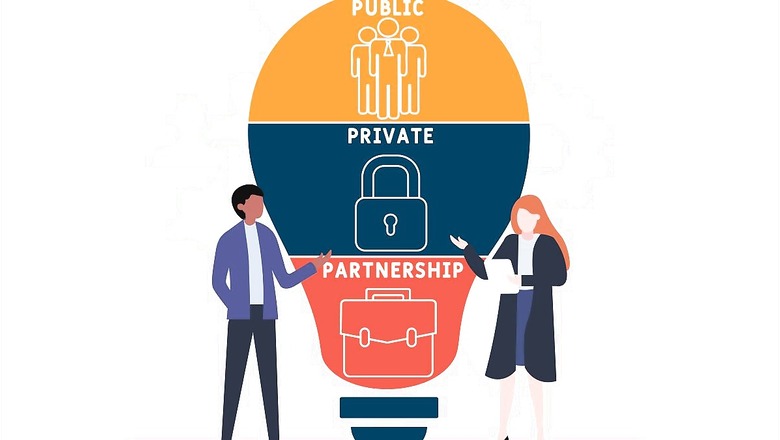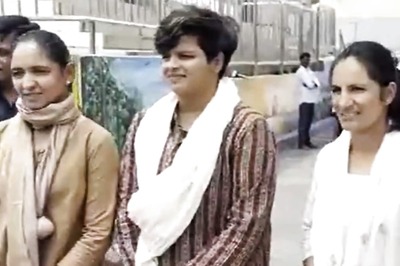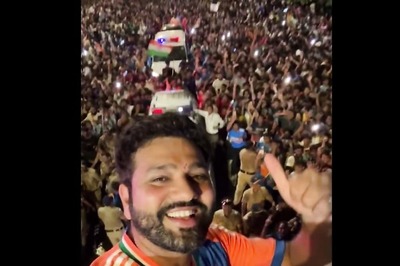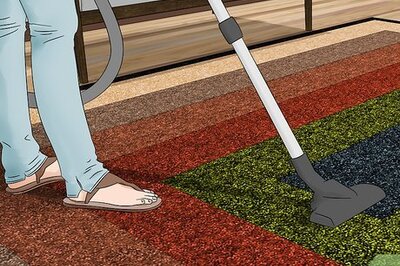
views
Monsoon is one of those times when every tiled surface turns into an obstacle course, or rather, a slippery challenge. It’s scary, even when we’re wearing wet weather shoes, and when we have the privilege of being able-bodied. For those with disabilities, the monsoon brings untold challenges in navigating our built environment.
One of the most inaccessible places for people with disabilities is usually the toilet. Spaces are often too narrow to be navigable, stalls aren’t broad enough for wheelchair access, there aren’t enough grab bars… and this is even before the monsoon turns the floor into a wet, slippery hazard.
Challenges Faced by People with Disabilities in Monsoon
Just like the rest of us, people with disabilities face many difficulties during the monsoon season, such as heavy rains, floods, landslides, and power outages. However, these can affect their mobility, health, and safety in a much more significant way. And then there is the indignity (and inconvenience) of a toilet that isn’t equipped for them. Imagine being driven for hours by rescuers to a ‘safe’ location, only to find that none of the toilets there are accessible to you. This is an unfortunate reality for many. Even on a daily basis, people with disabilities struggle with poorly designed toilets, that become downright dangerous during monsoons:
- They are often located far from main buildings or pathways, making them hard to access.
- They are poorly constructed and maintained, leading to leaks, clogs, overflows, and odours.
- They lack proper ventilation, causing mould, mildew, and insects to thrive.
- They have slippery floors and steps, increasing the risk of falls and injuries.
- They have narrow doors and stalls, preventing people with wheelchairs or crutches from entering or manoeuvring inside.
- They have inadequate or inappropriate fixtures, such as low or high seats, broken or missing handrails, and inaccessible sinks and mirrors.
These issues can have a negative impact on the daily lives of people with disabilities, affecting their hygiene, health, comfort, privacy, and dignity.
Design Considerations for Monsoon-Proof Accessible Toilets
Monsoon-proof toilets are toilets that can withstand the harsh weather conditions of the monsoon season without compromising their functionality or quality. However, we need to ensure that these toilets are available to all users, which means that they should be easy to reach, use, and exit for people with different types of disabilities. Some of the design considerations for monsoon-proof accessible toilets are:
- Incorporating universal design principles: Universal design is a concept that aims to create products and environments that are usable by all people regardless of their abilities or preferences.
- Waterproofing and drainage systems for monsoon conditions: Waterproof materials, raised floors, sloped roofs, gutters, pipes, pumps, valves, and filters can help prevent water damage and flooding in toilet facilities during the monsoon season.
- Proper ventilation to prevent moisture-related issues: It can help to reduce humidity levels, prevent mould growth, eliminate odours, and improve air quality..
- Non-slip flooring and handrails for enhanced safety: They should be made of materials that provide traction, such as rubber or textured tiles. Handrails should be installed along walls, staircases, and ramps, and should be sturdy, smooth, and easy to grip.
- Adequate space for manoeuvrability and accessibility: There should be enough space between fixtures, doors, and walls, as well as inside stalls, to accommodate people with wheelchairs or crutches. The minimum dimensions for accessible toilet stalls are 150 cm by 150 cm.
Inclusive Features for Accessible Toilets
Inclusive features are features that cater to the specific needs and preferences of people with different types of disabilities. They can help to enhance their comfort, convenience, and independence in using toilet facilities. Some of the inclusive features for accessible toilets are:
- Adjustable and supportive fixtures for different disabilities: that can be adjusted or modified to suit the needs of people with different disabilities.
- Braille signage and audio assistance for visually impaired individuals: that provide information and guidance to visually impaired individuals in using toilet facilities.
- Emergency call systems for assistance: that allow people with disabilities to request assistance in case of an emergency or difficulty in using toilet facilities.
- Accessible sinks, mirrors, and hand dryers: enable people with disabilities to wash their hands and face, check their appearance, and dry their hands in toilet facilities because of their lowered height.
- Gender-neutral and family-friendly considerations: respect the diversity and inclusivity of people with different genders and family situations and can accommodate parents with children or caregivers with dependents.
Supporting Infrastructure and Maintenance
These are elements that support the functionality and quality of toilet facilities. Some of the supporting infrastructure and maintenance for monsoon-proof accessible toilets are:
- Accessible pathways and ramps leading to toilets: They should be smooth, wide, and level, and should have no obstacles or barriers. They should also have handrails, signs, and markings.
- Proper lighting for improved visibility: It should provide adequate illumination for people with disabilities to see clearly and avoid accidents. It should also be energy-efficient and reliable.
- Regular maintenance and inspections for functionality and cleanliness: These should include tasks such as checking and repairing fixtures, cleaning and disinfecting surfaces, removing trash and debris, and replenishing supplies.
- Staff training for assisting people with disabilities: They should learn about the features and functions of monsoon-proof accessible toilets, the needs and rights of people with disabilities, and the best practices and etiquette for providing assistance.
Promoting Awareness and Advocacy
For many of us, this is a blindspot. We have the privilege of being able-bodied, and therefore, we don’t face these situations (or even think about them) until we fracture an arm, break a leg, or have to help a friend or family member who is going through it. This is why educating the public is the first step in being able to persuade people about the importance of inclusive toilet facilities for people with disabilities.
Harpic and News18’s Mission Swachhta aur Paani is a movement that upholds the cause of inclusive sanitation where everyone has access to clean toilets. For 3 years now, this initiative has advocated equality for all genders, abilities, castes and classes and championed the cause that clean toilets are a shared responsibility.
Mission Swachhta aur Paani is creating repositories of information on every conceivable topic around toilet use, and how it impacts us individually, as well as the larger society. You can use this information to lobby your local municipality, build community support through social media, or just educate people in your office and social circles, and get conversations started. For instance, if your workplace doesn’t have an accessible toilet, point it out to the decision makers, and let them know that this is a significant barrier to being able to hire people with disabilities.
There are many ways you can leverage the information at Mission Swachhta aur Paani, to make the world a better place. Join us here, to learn how.


















Comments
0 comment